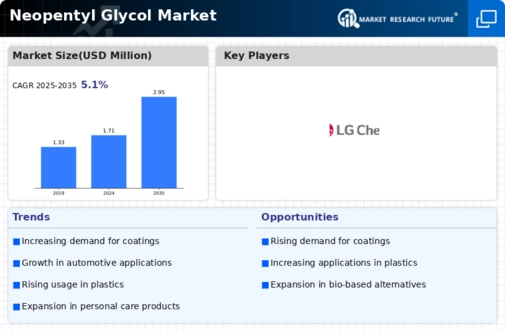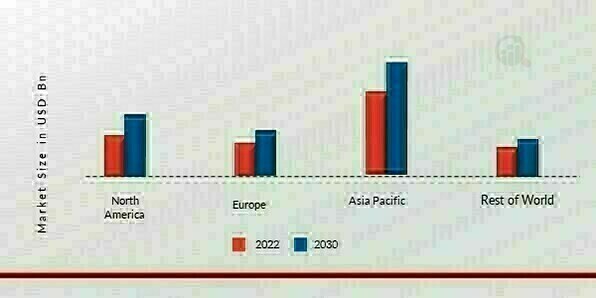-
Executive Summary
-
Scope of the Report
-
Market Definition
-
Scope of the Study
- Research Objectives
- Assumptions & Limitations
-
Markets Structure
-
Market Research Methodology
-
Research Process
-
Secondary Research
-
Primary Research
-
Forecast Model
-
Market Landscape
-
Supply Chain Analysis
- Raw Material Suppliers
- Manufacturers/Producers
- Distributors/Retailers/Wholesalers/E-commerce
- End Users
-
Porter’s Five Forces Analysis
- Threat of New Entrants
- Bargaining Power of Buyers
- Bargaining Power of Suppliers
- Threat of Substitutes
- Intensity of Competitive Rivalry
-
Market Dynamics of Global Neopentyl Glycol Market
-
Introduction
-
Drivers
-
Restraints
-
Opportunities
-
Challenges
-
Trends/Technology
-
Global Neopentyl Glycol Market by Type
-
Introduction
-
Molten
- Market Estimates & Forecast, 2025−2034
- Market Estimates & Forecast by Region, 2025−2034
-
Flakes
- Market Estimates & Forecast, 2025−2034
- Market Estimates & Forecast by Region, 2025−2034
-
Slurry
- Market Estimates & Forecast, 2025−2034
- Market Estimates & Forecast by Region, 2025−2034
-
Global Neopentyl Glycol Market by Application
-
Introduction
-
Coatings
- Market Estimates & Forecast, 2025−2034
- Market Estimates & Forecast by Region, 2025−2034
-
Adhesives & Sealants
- Market Estimates & Forecast, 2025−2034
- Market Estimates & Forecast by Region, 2025−2034
-
Insulation
- Market Estimates & Forecast, 2025−2034
- Market Estimates & Forecast by Region, 2025−2034
-
Plasticizers
- Market Estimates & Forecast, 2025−2034
- Market Estimates & Forecast by Region, 2025−2034
-
Fibers
- Market Estimates & Forecast, 2025−2034
- Market Estimates & Forecast by Region, 2025−2034
-
Agrochemicals
- Market Estimates & Forecast, 2025−2034
- Market Estimates & Forecast by Region, 2025−2034
-
Fuel Additives
- Market Estimates & Forecast, 2025−2034
- Market Estimates & Forecast by Region, 2025−2034
-
Dyes
- Market Estimates & Forecast, 2025−2034
- Market Estimates & Forecast by Region, 2025−2034
-
Emollient
- Market Estimates & Forecast, 2025−2034
- Market Estimates & Forecast by Region, 2025−2034
-
Others
- Market Estimates & Forecast, 2025−2034
- Market Estimates & Forecast by Region, 2025−2034
-
Global Neopentyl Glycol Market, by End-use industry
-
Introduction
-
Paints & Coatings
- Market Estimates & Forecast, 2025−2034
- Market Estimates & Forecast by Region, 2025−2034
-
Automotive
- Market Estimates & Forecast, 2025−2034
- Market Estimates & Forecast by Region, 2025−2034
-
Construction
- Market Estimates & Forecast, 2025−2034
- Market Estimates & Forecast by Region, 2025−2034
-
Chemicals
- Market Estimates & Forecast, 2025−2034
- Market Estimates & Forecast by Region, 2025−2034
-
Plastics
- Market Estimates & Forecast, 2025−2034
- Market Estimates & Forecast by Region, 2025−2034
-
Textiles
- Market Estimates & Forecast, 2025−2034
- Market Estimates & Forecast by Region, 2025−2034
-
Pharmaceuticals
- Market Estimates & Forecast, 2025−2034
- Market Estimates & Forecast by Region, 2025−2034
-
Cosmetics & Personal Care
- Market Estimates & Forecast, 2025−2034
- Market Estimates & Forecast by Region, 2025−2034
-
Others
- Market Estimates & Forecast, 2025−2034
- Market Estimates & Forecast by Region, 2025−2034
-
Global Neopentyl Glycol Market, by Region
-
Introduction
-
North America
- Market Estimates & Forecast, 2025−2034
- Market Estimates & Forecast by Type, 2025−2034
- Market Estimates & Forecast by Application, 2025−2034
- Market Estimates & Forecast by End-use Industry, 2025−2034
- U.S.
- Canada
-
Europe
- Market Estimates & Forecast, 2025−2034
- Market Estimates & Forecast by Type, 2025−2034
- Market Estimates & Forecast by Application, 2025−2034
- Market Estimates & Forecast by End-use Industry, 2025−2034
- Germany
- France
- Italy
- Spain
- U.K.
- Russia
- Poland
-
Asia Pacific
- Market Estimates & Forecast, 2025−2034
- Market Estimates & Forecast by Type, 2025−2034
- Market Estimates & Forecast by Application, 2025−2034
- Market Estimates & Forecast by End-use Industry, 2025−2034
- China
- India
- Japan
- Australia
- New Zealand
- Rest of Asia Pacific
-
Middle East & Africa
- Market Estimates & Forecast, 2025−2034
- Market Estimates & Forecast by Type, 2025−2034
- Market Estimates & Forecast by Application, 2025−2034
- Market Estimates & Forecast by End-use Industry, 2025−2034
- Turkey
- Israel
- North Africa
- GCC
- Rest of Middle East & Africa
-
Latin America
- Market Estimates & Forecast, 2025−2034
- Market Estimates & Forecast by Type, 2025−2034
- Market Estimates & Forecast by Application, 2025−2034
- Market Estimates & Forecast by End-use Industry, 2025−2034
- Brazil
- Mexico
- Argentina
- Rest of Latin America
-
Company Landscape
-
Introduction
-
Market Strategy
-
Key Development Analysis (Expansion/Merger & Acquisitions/Joint Venture/New Product Development/Agreement/Investment)
-
Company Profiles
-
BASF SE
- Company Overview
- Financial Updates
- Product/Business Segment Overview
- Strategy
- Key Developments
- SWOT Analysis
-
Celanese Corporation
- Company Overview
- Financial Updates
- Product/Business Segment Overview
- Strategy
- Key Developments
- SWOT Analysis
-
Eastman Chemical Company
- Company Overview
- Financial Updates
- Product/Business Segment Overview
- Strategy
- Key Developments
- SWOT Analysis
-
LG Chem
- Company Overview
- Financial Updates
- Product/Business Segment Overview
- Strategy
- Key Developments
- SWOT Analysis
-
MITSUBISHI GAS CHEMICAL COMPANY, INC.
- Company Overview
- Financial Updates
- Product/Business Segment Overview
- Strategy
- Key Developments
- SWOT Analysis
-
OXEA GmbH
- Company Overview
- Financial Updates
- Product/Business Segment Overview
- Strategy
- Key Developments
- SWOT Analysis
-
Perstorp Orgnr
- Company Overview
- Financial Updates
- Product/Business Segment Overview
- Strategy
- Key Developments
- SWOT Analysis
-
Polioli S.p.A.
- Company Overview
- Financial Updates
- Product/Business Segment Overview
- Strategy
- Key Developments
- SWOT Analysis
-
Oleon NV
- Company Overview
- Financial Updates
- Product/Business Segment Overview
- Strategy
- Key Developments
- SWOT Analysis
-
Shandong Dongchen New Technology Co,Ltd.
- Company Overview
- Financial Updates
- Product/Business Segment Overview
- Strategy
- Key Developments
- SWOT Analysis
-
Conclusion
-
LIST OF TABLES
-
Global Neopentyl Glycol market: By Region, 2025−2034
-
North America Neopentyl Glycol market: By Country, 2025−2034
-
Europe Neopentyl Glycol market: By Country, 2025−2034
-
Asia-Pacific Neopentyl Glycol market: By Country, 2025−2034
-
Middle East & Africa Neopentyl Glycol market: By Country, 2025−2034
-
Latin America Neopentyl Glycol market: By Country, 2025−2034
-
Global Neopentyl Glycol Type Market: By Regions, 2025−2034
-
North America Neopentyl Glycol Type Market: By Country, 2025−2034
-
Europe Neopentyl Glycol Type Market: By Country, 2025−2034
-
Table10 Asia-Pacific Neopentyl Glycol Type Market: By Country, 2025−2034
-
Table11 Middle East & Africa Neopentyl Glycol Type Market: By Country, 2025−2034
-
Table12 Latin America Neopentyl Glycol Type Market: By Country, 2025−2034
-
Table13 Global Neopentyl Glycol Application Market: By Regions, 2025−2034
-
Table14 North America Neopentyl Glycol by Application Market: By Country, 2025−2034
-
Table15 Europe Neopentyl Glycol Application Market: By Country, 2025−2034
-
Table16 Asia-Pacific Neopentyl Glycol Application Market: By Country, 2025−2034
-
Table17 Middle East & Africa Neopentyl Glycol Application Market: By Country, 2025−2034
-
Table18 Latin America Neopentyl Glycol Application Market: By Country, 2025−2034
-
Table19 Global Neopentyl Glycol End-use Industry Market: By Regions, 2025−2034
-
Table20 North America Neopentyl Glycol End-use Industry Market: By Country, 2025−2034
-
Table21 Europe Neopentyl Glycol End-use Industry Market: By Country, 2025−2034
-
Table22 Asia-Pacific Neopentyl Glycol End-use Industry Market: By Country, 2025−2034
-
Table23 Middle East & Africa Neopentyl Glycol End-use Industry Market: By Country, 2025−2034
-
Table24 Latin America Neopentyl Glycol End-use Industry Market: By Country, 2025−2034
-
Table25 Global Type Market: By Region, 2025−2034
-
Table26 Global Application Market: By Region, 2025−2034
-
Table27 Global End-use Industry Market: By Region, 2025−2034
-
Table28 North America Neopentyl Glycol market, By Country
-
Table29 North America Neopentyl Glycol market, By Type
-
Table30 North America Neopentyl Glycol market, By Application
-
Table31 North America Neopentyl Glycol market, By End-use Industry
-
Table32 Europe: Neopentyl Glycol market, By Country
-
Table33 Europe: Neopentyl Glycol market, By Type
-
Table34 Europe: Neopentyl Glycol market, By Application
-
Table35 Europe: Neopentyl Glycol market, By End-use Industry
-
Table36 Asia-Pacific: Neopentyl Glycol market, By Country
-
Table37 Asia-Pacific: Neopentyl Glycol market, By Type
-
Table38 Asia-Pacific: Neopentyl Glycol market, By Application
-
Table39 Asia-Pacific: Neopentyl Glycol market, By End-use Industry
-
Table40 Middle East & Africa: Neopentyl Glycol market, By Country
-
Table41 Middle East & Africa Neopentyl Glycol market, By Type
-
Table42 Middle East & Africa Neopentyl Glycol market, By Application
-
Table43 Middle East & Africa: Neopentyl Glycol market, By End-use Industry
-
Table44 Latin America: Neopentyl Glycol market, By Country
-
Table45 Latin America Neopentyl Glycol market, By Type
-
Table46 Latin America Neopentyl Glycol market, By Application
-
Table47 Latin America: Neopentyl Glycol market, By End-use Industry
-
LIST OF FIGURES
-
Global Neopentyl Glycol market segmentation
-
Forecast Printing methodology
-
Porter’s Five Forces Analysis of Global Neopentyl Glycol market
-
Value Chain of Global Neopentyl Glycol market
-
Share of Global Neopentyl Glycol market in 2020, by country (in %)
-
Global Neopentyl Glycol market, 2025−2034,
-
Global Neopentyl Glycol market size by Type, 2020
-
Share of Global Neopentyl Glycol market by Type, 2025−2034
-
Global Neopentyl Glycol market size by Application, 2020
-
Share of Global Neopentyl Glycol market by Application, 2025−2034
-
Global Neopentyl Glycol market size by End-use Industry, 2020
-
Share of Global Neopentyl Glycol market by End-use Industry, 2025−2034


 Source: Secondary Research, Primary Research, Market Research Future Database, and Analyst Review
Source: Secondary Research, Primary Research, Market Research Future Database, and Analyst Review

Leave a Comment